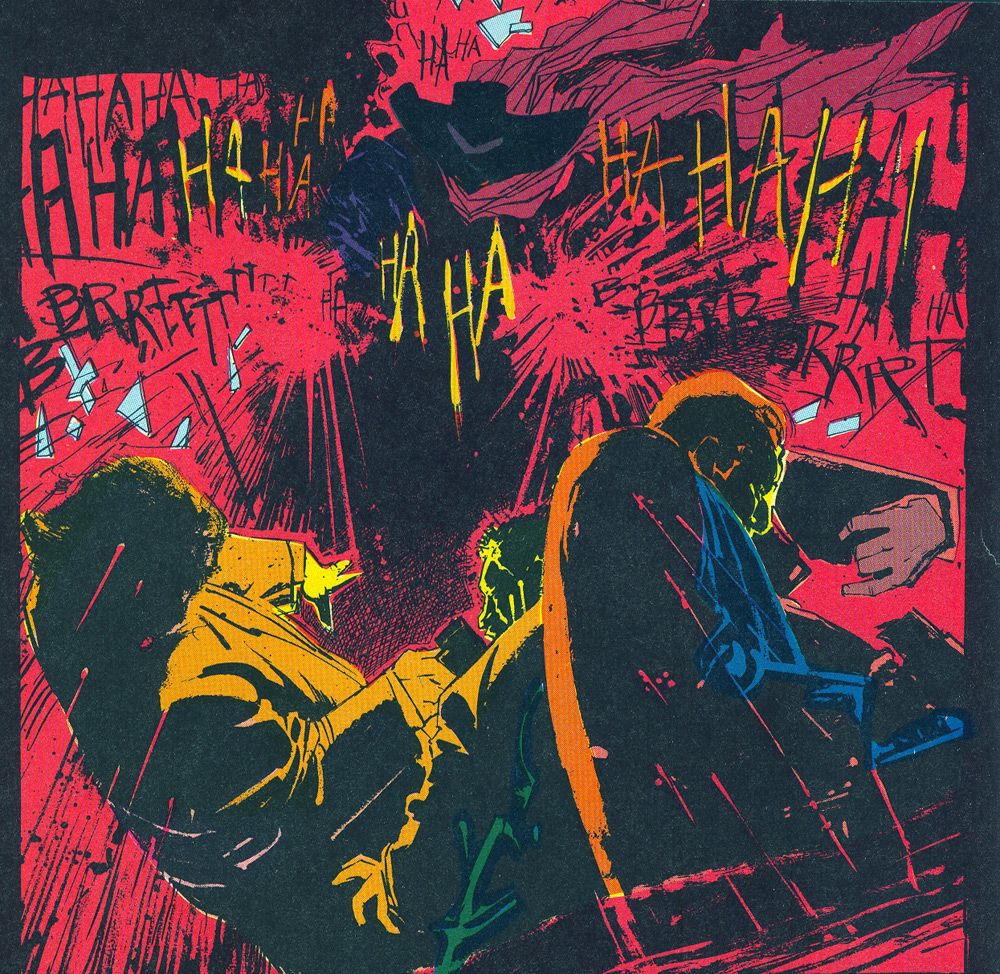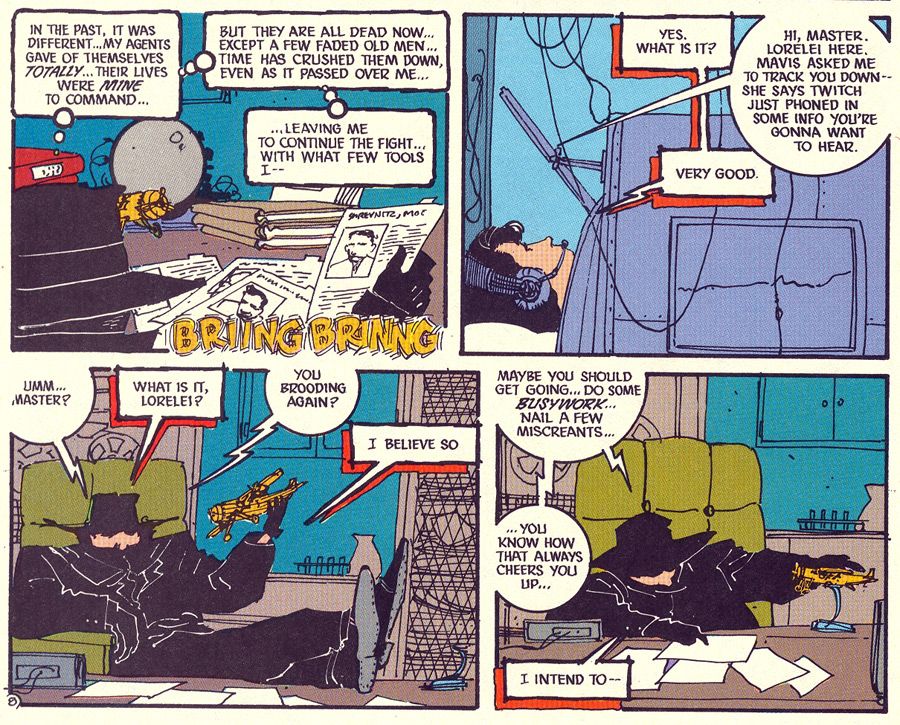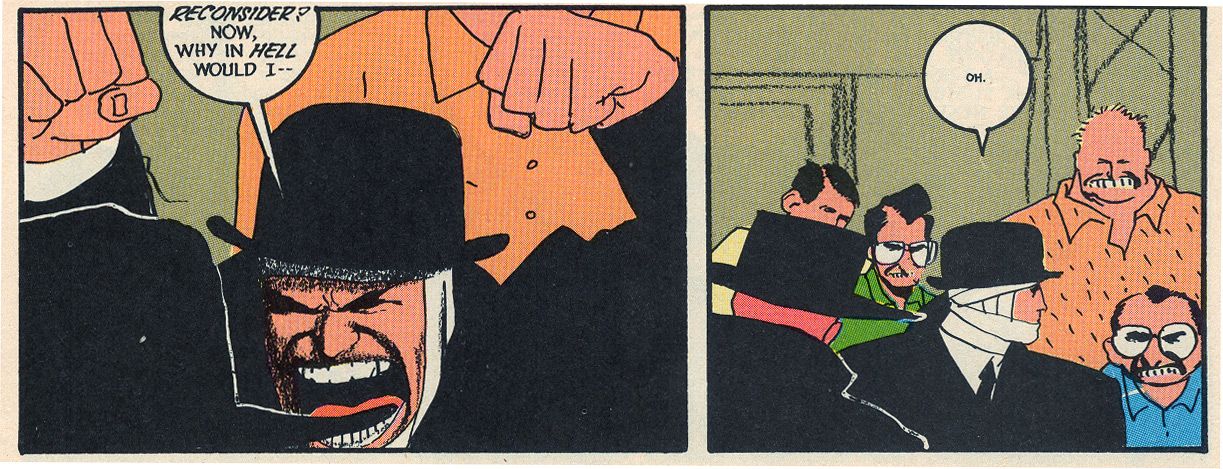In my debut CTN column, I raved about Justice Inc., a two-part prestige format series DC put out in the late 1980s, written by Andrew Helfer and drawn by Kyle Baker. The book starred a long-forgotten pulp hero known as the Avenger. That comic was actually a spin-off of another comic Helfer and Baker were doing at the time, which was also based off of a pulp hero, although in his case he was far from forgotten. I'm talking, of course, about The Shadow.
On the off chance you may not be familiar with the Shadow I'll provide a quick synopsis. His origin varies (and has been altered numerous times over the years) but basically he's a rich socialite who garnered the ability in some far-off, mystical Eastern land to "cloud men's minds" and turn invisible. He doffs a black trench coat and hat (along with natty red scarf) to fight crime, which he mainly does by repeatedly shooting at them until they're dead. He's mainly known for saying stuff like "the weed of crime bears bitter fruit" and cackling maniacally. Oh, and he often employs a vast array of agents to help him in his efforts to slaughter criminals. (And if you really want to know more I recommend turning to Wikipedia at this point.)
Anyway, there's been a number of attempts to get revive the character, especially in comics. The specific Shadow series that I'm talking about today though was actually a spin-off of a four-part mini-series by Howard Chaykin. Rather than attempt to tell tales set in the classic pulp era of the 1930s, Chaykin tried to bring the character into modern times in his own indomitable fashion. Namely, he handed him an uzi, added plentiful dollops of sex, kink and blood, threw in some sharp social commentary and was off to the races.
Blood & Judgement (as the collected version was called) was popular enough to warrant a monthly title, but Chaykin apparently wasn't interested in being tied down, there were other DC characters that needed revamping. Enter writer/editor Helfer, who would eventually helm DC's Paradox Press line, as well as edit the "bwah hah hah" era of the Justice League. Helfer was initially joined by then-hotsy-totsy-artist-of-the-day Bill Sienkiewicz, who, like Chaykin, found a way to offer his own unique interpretation of the character without going too far beyond the boundaries of "Shadowness."
Already things were a bit off-kilter though. Not content with the new cast of characters Chaykin had whipped up, Helfter added a few of his own, many of whom, like Twitchkowitz, a nervous, nerdish fellow with a passion for pharmaceuticals, seemed bizarre even by Blood & Judgement's standards. Helfer didn't seem to have much interest exploring the Shadow's character or ethos the way Chaykin did either. All of the sex stuff got dumped immediately. And while no one would ever accuse Chaykin of lacking a sense of humor, Helfer seemed at times seemed more interested in delivering a good joke than in delivering classic pulp thrills.
Those aspects would become much more pronounced once Kyle Baker took over the art chores in issue number eight:
Baker was pretty new to the comics scene when he started on the Shadow. Seminal works like Why I Hate Saturn were still down the pike. He had completed The Cowboy Wally Show, but Doubleday wouldn't release that for several months yet. So for many comics readers Shadow was their first introduction to Baker's work, and it would give them the opportunity to see him grow as an artist as well.
It became clear pretty quickly that neither Helfer nor Baker felt any reverence for the Shadow or his milieu. Indeed, he quickly became portrayed as something of a psychopath, little different from many of the villains he fought, and often treating his minions like trash. And while bullets were still fired in abundance and blood flowed freely, the series itself turned from high, action packed (while slightly campy) melodrama into something of a black comedy, a dark, slapstick farce that not only mocked its protagonist, but just about everyone else in the cast -- and the whole romantic notion of the anti-hero to boot. There's very few identifiable or likable characters here, which perhaps, makes their interactions all the more amusing.
Baker stuck to a eight panel grid throughout his entire run on the series, cramming each panel with loads of detail and Mad magazine-like asides. He frequently alternated between drawing his characters in a realistic style and then reverting to cartoonish exaggeration, depending upon their emotional state. Baker was clearly going for the funny bone as much as he was the jugular. The cast often moved at 45 degree angles, their backs bent into a question-mark shape. Their tosos frequently seemed too large and square for their spindly legs and arms. They also all seemed to be wearing shoulder pads for some reason, but then again, it was 1988.
A master of facial expressions, Baker frequently offered tight close-ups that highlighted his gift for depicting enraged characters with their mouths open ten times their normal width and their clenched fists raised to the sky.
For his part, Helfer juggled increasingly loopy, labyrinthine plots that frequently seemed to take on (and subsequently murder) characters every issue. Despite it's density, however, the stories never once seemed capable of tipping over into incomprehensibility or insufferability, even as they started including elements like an impossibly obese Irish women, a dangerous group of teenage video arcade junkies and a murderous gorilla.
The whole thing reached a fever pitch in issue number 19, in which the recently deceased Shadow was resurrected by having his head (which had been severed from its body by a helicopter blade of all things) mounted onto that of a cyborg body.
And that was the end. The series was canceled after that and DC tried again with The Shadow Strikes, a more tried and true title set during the Depression. The rumor mill continues to speculate that Shadow copyright owners Conde Nast didn't like what Helfer and Baker were doing with their potential cash cow one bit and pulled the plug on the series as soon as possible. For his part, Baker has always maintained that the series was canceled due to poor sales and nothing more.
Whether it was poor sales or a unhappy copyright owner, the fact remains neither DC nor Conde Nast seem to be in that much of a hurry to get this material back out to the public. And that's a real shame because even though back issues are cheap and not too hard to find, a trade collecting this work (and ideally, including Sinkiewicz's run as well as the one issue drawn by Marshall Rogers) would, I think, bring about a new appreciation for what Helfer and Baker did. By refusing to be beholden to nostalgia or the then popular "grim and gritty" ethos, the two were able to create a manic, inspired and downright hilarious comic that is quite unlike anything that was being published at the time or has come down the pike since.





